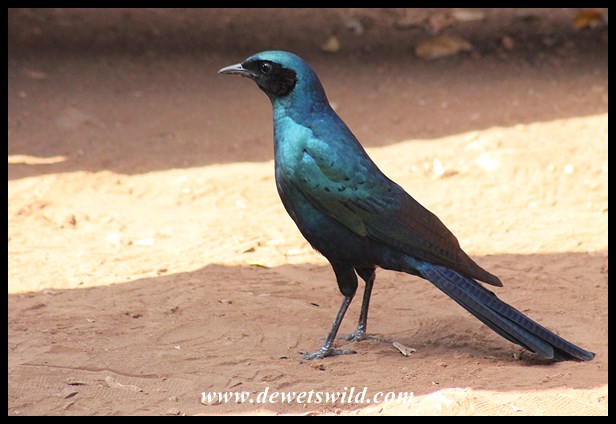Lamprotornis australis
Burchell’s Starling inhabits savannas and woodlands with large thorn trees and patches of open terrain, foraging mostly on the ground for invertebrates, flowers and fruit. They also scavenge for scraps at picnic spots.
These large (34cm long, weighing 120g) starlings breed during summer, usually in cavities in trees lined with grass, leaves, feathers, snake skin and occasionally paper and other human waste material. The female lays 2-4 eggs and is responsible for incubation, which takes about two weeks, but both parents feed the chicks until they leave the nest at about 3 weeks of age.
Burchell’s Starling occurs in only a few southern African countries: marginally into Angola, Zambia, Mozambique, Swaziland and Zimbabwe, with the core of their distribution centred on Namibia, Botswana and South Africa, where they occur in the Lowveld of Mpumalanga, Limpopo and the North West with a few scattered records elsewhere. The IUCN considers the species of least concern.




















I had to look up the Afrikaans for starling(spreeu). We do not get those starlings here. Does Australis mean it originates from Australia?
LikeLiked by 1 person
Very interesting question, Ineke. The latin name “australis” translates to “of the south”. Australia as a name is therefore rooted in the same word.
LikeLike
Ah ha, thanks for the info.
LikeLiked by 1 person
As dit dalk help met soorte wat jy nie ken nie, Ineke: ek sit altyd die Afrikaanse naam in die post se “tags” onderaan.
LikeLike
Oooo, dankie. Ek toets ook maar my kennis. Nou sal ek dit vinniger kan doen. Ek wil nie my Afrikaanse voëlkennis sommer laat roes nie.
LikeLiked by 1 person
So beautiful! Their colors are stunning. Thank you for sharing them with us!
LikeLiked by 1 person
We can never grow tired of seeing them either!
LikeLiked by 1 person
What a beautiful bird. I love the coloring.
LikeLiked by 1 person
Thanks, Maralee!
LikeLike
Starlings are really beautiful birds. And you have many in South Africa. We have one in Sweden, which is just called starling. (Common starling or European starling) It is also beautiful, but you do not see it at distance, it looks completely brown, but it also shines with a lot of dots. How many starlings have you in South Africa?
LikeLiked by 1 person
Altogether, we have eleven kinds of starlings in South Africa, John.
Of those we’ve now featured 5 here on our blog (Burchell’s, Cape Glossy, Greater Blue-eared, Pied and Red-Winged).
One of them only visits in summer (Violet-backed), and two are introduced invaders (the Common Starling you mentioned, and the Common Myna).
The remaining species indigenous to South Africa are the Black-bellied, Meves’s and Pale-winged.
LikeLiked by 1 person
I love their colors, de Wets. Great collection!
LikeLiked by 1 person
Thanks, Jane. They really shine in full sunlight!
LikeLiked by 1 person
Wow! beautiful colours! 🙂
LikeLiked by 1 person
Especially in full sunlight, Teresa!
LikeLiked by 1 person
At first glance the Burchell’s starling looks similar to the Cape Glossy Starling but just without the yellow ring around its eyes, however, the photos clearly capture its bigger size and longer tail. Nice one!
LikeLiked by 1 person
The different kinds of glossy starlings can be quite challenging to tell apart!
LikeLiked by 1 person